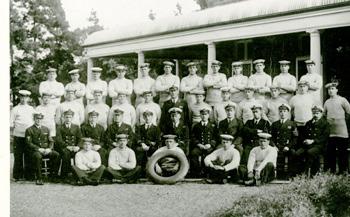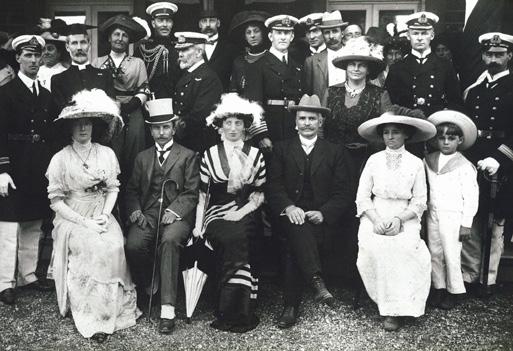
4 minute read
Naval Historical Society of Australia (Victoria Chapter)
J Class submarine crew at Osborne House in the 1920s.

Advertisement

Osborne House jetty circa 1914
An important part of Australia’s Naval and Military history
Early 20th century Royal Australian Navy Nursing Officer Uniform
Osborne House and its stables and surrounding lands hold important historical value to Victoria’s naval and military communities, and it is the only property in Geelong with such a broad Department of Defence history.
During 1913 and 1914, Osborne House operated as The Royal Australian Navy’s inaugural Naval College. The college took two intakes of 13-yearold boys while the permanent Royal Australian Naval College, HMAS Creswell, was built at Jervis Bay. ‘The first intake of boys, known as the “Pioneer Class” of 1913, contained many notable graduates, including Vice Admiral Sir John Collins, Rear Admiral Harold Farncomb and Rear Admiral Henry Showers, who all had distinguished wartime careers at senior levels. Admirals Collins and Farncomb were honoured by having two current submarines named after them.
Captain Andrew Mackinnon, President of the Naval Historical Society of Australia (Victoria Chapter), said Osborne House and its adjoining buildings and lands represent a vital heritage link to the early history of the Royal Australian Navy and the wider military community.
Osborne House’s military connection continued during World War I, and the house and stables became an army hospital. From 1917, the buildings became a Red Cross convalescent home for ‘war worn’ nurses. The nurses were invalided home to recuperate following their time spent caring for Australian soldiers during the war. Between 1919 and 1924, the house was used as the Royal Australian Navy’s submarine squadron headquarters, comprising six J-Class submarines. Some of these operated from a wharf in St. Helens Bay until the late 1920s. When World War II broke out in 1939, the Department of Defence once again took over Osborne House as an army training centre. In more recent years, the stables have been home to the Geelong Naval and Maritime Museum, and former Navy volunteers have assembled the collection of unique, historical items over decades.
“Continuing the curation, recording, preservation and display of the museum collection is of particular concern to the Navy community in Victoria,” Captain Mackinnon said. “With the museum
The Official Party at the opening of the Royal Australian Naval College at Osborne House, 1913 Front row left to right: Mrs Chambers, Lord and Lady Denman, Prime Minister Fisher and Mrs Pearce

Second row left to right: Lieutenant Commander Grant, Rev Hall, Rear Admiral Creswell, Captain Chambers, Senator Pearce, Mrs Fisher and Mr Brown
re-established within the stables, this would ideally be open for public viewing five or more days a week.” “When properly displayed, the collection has the potential to convey the important connection between Geelong, the Royal Australian Navy and the wider maritime industry in the region.” The Naval Historical Society of Australia (Victoria Chapter) envisions that the re-orientation of Osborne House, the stables and surrounding land will revitalise the history of these organisations at this scenic location. “We hope it will maintain its availability to community groups, including youth groups, who may benefit from waterfront access and classroom-style facilities within the building,” Captain Mackinnon said. “We envision the redevelopment will entice casual visitors with the fascinating historic charm and elegance of the property while providing a sophisticated venue for programmed events. Such uses might include modest conventions, conferences, art exhibitions, weddings, fine dining and more casual entertainment opportunities.” “Having such events occur on the site would provide ample opportunity for patrons to be given material that informs their experience by explaining the heritage of the location and its past role in Geelong’s history. Osborne House and the stables could become an adjunct to the Wool Museum or other heritage collections to broaden its appeal.” “If significant development of the site is proposed, ideally this should be behind the House and stables, such that their vista to the water and heritage external appearance is preserved.” Ports Victoria, as a custodian of the port’s waters, wishes to acknowledge the important connection of Osborne House to the maritime community and has expressed support for ongoing community access to Osborne House and lands.
For the Naval Historical Society of Australia (Victoria Chapter) complete response, click here.









